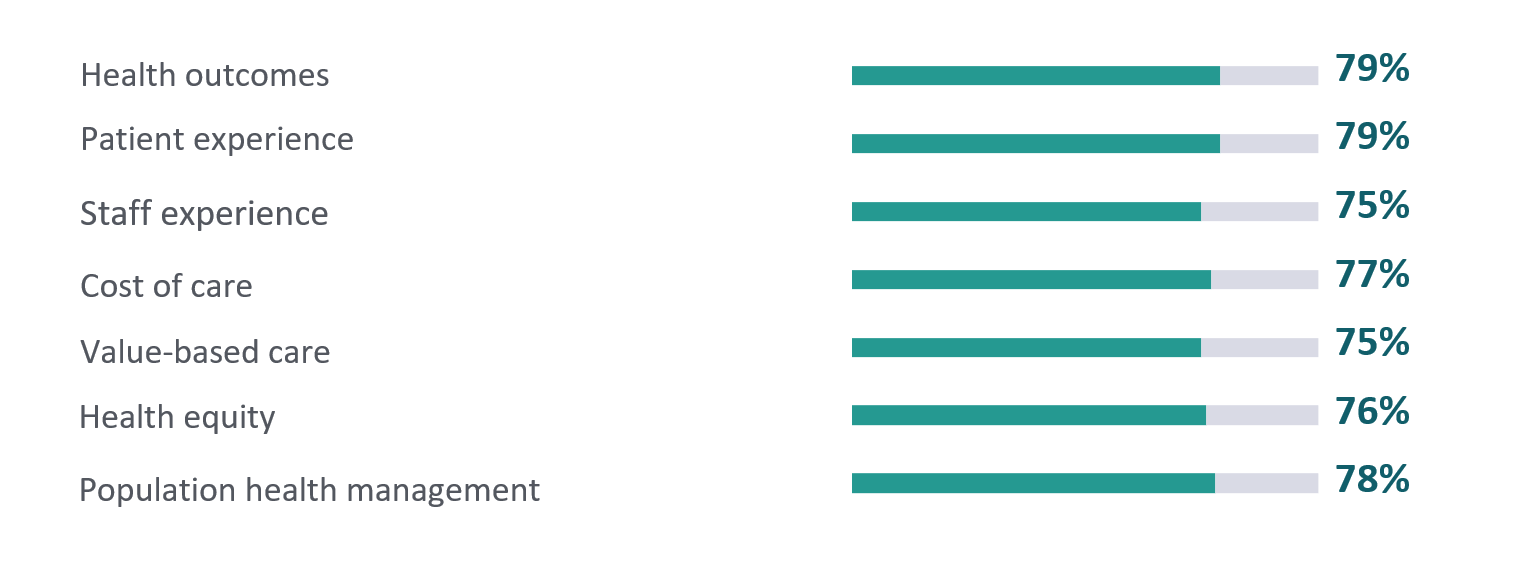Bridging the gap: Addressing Australia’s healthcare workforce challenges
Oct 15, 2022 - Reading time 5-7 minutes
Australian healthcare leaders surveyed for the Philip’s Future Health Index 2022 (FHI 2022) identified improving access and being at the forefront of healthcare delivery as their leading priorities for the next year. But to achieve this, they will need to overcome a myriad of challenges facing its healthcare workforce.
Reflecting a global post-pandemic labour shortage [1], the workforce gap in Australia’s Healthcare sector has grown exponentially over the past two years. The skills needed for healthcare delivery are also changing as digitisation transforms the sector. The problem has become so pressing that in April 2022, the Australian Private Hospitals Association described it as “the single biggest challenge facing health care in Australia [2]”. The availability of skilled staff is not a new issue for Australia’s healthcare industry. In 2017, a position statement from the Australian Healthcare and Hospitals Association (AHHA) highlighted systemic problems with aging staff and growing demand. They estimated that Australia’s health workforce would face a deficit of around 110,000 nurses and 2,700 doctors by 2025 [3].
However, these problems have been exacerbated by the covid-19 pandemic. Closed borders that prevented migration, the suspension of elective surgeries, burnout among healthcare workers, and record levels of covid-19 hospitalisations in 2022 have seen patient demand increase rapidly while the numbers of skilled healthcare staff fall. As a result, the proportion of healthcare and social assistance businesses reporting job vacancies has risen dramatically from 8.2% in February 2020, to 26.7% in May 2022 [4].
“We have never experienced such an extreme shortage of qualified health workers in Australia…but many of the solutions are complex and take time to deliver,” the CEO of the Victorian Healthcare Association, Tom Symondson, said of the challenge in a May 2022 opinion piece [5].

Structural transformation
There are a number of federal and state government policies, both existing and new, that have been implemented to address this issue. The federal Innovative Models of Care (IMOC) grants program, for example, has committed $35 million to trial a set of novel approaches to address health workforce shortages and improve patient outcomes in rural and remote Australia [6]. Yet as Mr Symondonson notes in his opinion piece, the present workforce problems facing Australia’s healthcare sector cannot be solved by “simply throwing more money at the system”.
Many of the underlying issues are structural, and traditional solutions—like tertiary training programs and hiring healthcare workers from overseas nations [7]—are no longer feasible. Learning now needs to take a life-long approach and, while borders may now be open, overseas hiring remains difficult as many countries are facing similar shortfalls. Indeed, the World Health Organisation estimates a worldwide shortfall of 15 million healthcare workers by 2030 [8].
The rapid digitisation of Australia’s healthcare sector during the pandemic adds to the complexity. Not only do Australia’s healthcare leaders need to find new staff to fill vacancies, they need to explore ways to transition current employees to new and different ways of working and build their “digital IQ”. They also need to consider future workforce requirements as the sector continues to transform and technologies like artificial intelligence (AI) and predictive analytics become mainstream.
Healthcare skills solutions
The Australian government recently raised the permanent migration cap by 35,000 to reach a quota of 195,000 places in the 2022/2023 financial year . Yet this is just the tip of the iceberg for many healthcare leaders, and myriad medical and university organisations, from the Group of Eight [10], to the Australian Nurses and Midwifery Federation and the Australian Medical Association (AMA) [11], are calling for further government action. Australian healthcare leaders are also trying to find ways to reduce the pressure on the doctors, nurses, caregivers and administrative staff and over one quarter (27%) of respondents in FHI 2022 say they are taking steps to improve staff satisfaction and address staff shortages.
As the AMA president notes in his calls for action, this also requires state and federal governments to work together to address the problem in a national manner, rather than leave individual states to find solutions, which sometimes leaves them competing against each other for staff.
Understanding that the impact of government policies is likely to be longer-term, many healthcare leaders are taking matters into their own hands and are exploring new models of hiring and training. For example, to address its nursing shortfall, Estia Health, an aged care provider, has shifted its strategy to reduce its casual staff and focus on growing and developing its permanent workforce. Meanwhile Ramsay Healthcare hired 550 nursing graduates straight from graduation in February 2022, its largest ever graduate intake [12].
However, the workforce challenges are so deep at present, this has left many groups fighting each other for what is a limited pool of potential staff.
Digital health innovation
Technology may have compounded Australia’s healthcare workforce challenges, but it may also hold the key to one of the solutions in the medium to long term. As AI, machine learning and predictive analytics have grown in sophistication, their application in a healthcare setting can improve diagnostics and treatment, and reduce the pressure on frontline staff.
Predictive analytics, which uses statistical algorithms and machine learning to make future predictions based on medical data, has the potential to help healthcare leaders reduce the burden on their administrative staff and improve health outcomes. According to the 2022 Future Health Index, just over half (55%) of Australian healthcare leaders have already adopted or are in the process of adopting predictive analytics, with 33% of surveyed leaders planning to adopt in the coming 3 years.

Figure 1. How positive of an impact do you think the use of predictive analytics can have on the following aspects of care?
AI and intelligent automation also harness technology to reduce repetitive work that frees clinicians in areas like radiation oncology and medical imaging to focus on more cognitive diagnosis while improving the consistency of the treatment outcomes . By reducing the repetitive work staff need to do, AI and robotics can also greatly increase the efficiency of a busy department.
More technology means more and better management of data, which itself brings new healthcare workforce challenges, but in the longer term, technological innovation can significantly reduce workforce pressures. And most importantly, increase access to quality healthcare to more people in rural and regional Australia, and globally.
[1] The post-covid-19 rise in labour shortages, OECD Economics Department Working Papers No. 1721. https://www.oecd-ilibrary.org/docserver/e60c2d1c-en.pdf?expires=1662637429&id=id&accname=guest&checksum=68A5564C8838F63962F43CC4381E562C
[2] Election health policy announcements pointless until workforce shortages are addressed, The Australian Private Hospitals Association, April 13th 2022. chrome-extension://efaidnbmnnnibpcajpcglclefindmkaj/https://apha.org.au/wp-content/uploads/2022/04/Election-health-policy-announcements-pointless-until-workforce-shortages-are-addressed.pdf
[3] Health Workforce, Australian Healthcare & Hospitals Association potion statement, May 2017. https://ahha.asn.au/sites/default/files/docs/policy-issue/ahha_position_statement_-_health_workforce_3.pdf
[4] Quarterly Job Vacancies Survey, The Australian Bureau of Statistics, May 2022. https://www.abs.gov.au/statistics/labour/jobs/job-vacancies-australia/latest-release
[5] Australia urgently needs a health workforce plan, Tom Symondson, The Age, May 2nd 2022. https://www.theage.com.au/national/victoria/australia-urgently-needs-a-health-workforce-plan-20220502-p5aho6.html
[6] Delivering innovative health care in rural Western Australia, Department of Health and Aged Care media release,
[7] Train your own nurses, Australia told amid global shortage, Dana Daniel, The Sydney Morning Herald, Dana Daniel, July 29th 2022. https://www.smh.com.au/politics/federal/train-your-own-nurses-australia-told-amid-global-shortage-20220725-p5b4b2.html
[8] Global strategy on human resources for health: Workforce 2030, World Health Organization, 7 July 2020. https://www.who.int/publications/i/item/9789241511131
[9] The government has increased the skilled migration cap to 195,000. So what do those who want or hold a visa think about it? The ABC, September 3rd 2022. https://www.abc.net.au/news/2022-09-03/skilled-migration-cap-increase-visa-backlog-explotation-concerns/101400178
[10] Securing Australia’s medical workforce will avert pending health crisis, media release, Group of Eight Australia, May 5th 2022. https://go8.edu.au/media-release-securing-australias-medical-workforce-will-avert-pending-health-crisis
[11] AMA urges federal government to fix “broken” healthcare system as NSW paramedics protest shortages. https://www.theguardian.com/australia-news/2022/may/28/ama-urges-federal-government-to-fix-broken-health-system-as-nsw-paramedics-protest-shortages
[12] Rival health providers fighting for nurses amid staff shortage, HelloCare, February 23rd 2022. https://hellocare.com.au/rival-health-providers-fighting-for-nurses-amid-staff-shortage/
[13] The promise of AI in healthcare, Matt Moran, Managing Director of Philips Australia and New Zealand, Philips, August 31st 2022. https://www.philips.com.au/a-w/about/news/archive/standard/news/articles/2022/20220831-the-promise-of-ai-in-healthcare.html
Stay up to date and subscribe
Sign up to stay informed and receive information on healthcare innovation, straight to your inbox








